The 6 Best Moodle Alternatives in 2026

Moodle has rightfully earned its place as one of the most popular learning platforms in the industry. It’s loved by teachers, educators, and businesses for its ease of use and solid learning management capabilities.
But what if the tool doesn’t meet all your needs and you want to consider Moodle alternatives? Whether you’re seeking extended capabilities or a more intuitive user experience, this article’s got you covered. We’ve put together a list of 6 best Moodle replacements for various use cases and scenarios, from corporate training to academic environments. Feel free to explore and compare them to find the best learning management software for your specific needs.
What is Moodle?
Moodle is a popular open-source learning management system (LMS) that allows educators to set up and manage online courses and training programs. It’s actively used by schools, independent educators, and businesses, thanks to a simple interface and solid capabilities. You can upload and deliver interactive courses, create quizzes, and track learner progress. It’s also easy to foster discussion among learners for effective collaborative learning.

Moodle interface
While the basic capabilities of Moodle are zero-cost, you can invest in premium features, professional hosting, and add-ons to expand its functionality. In other words, the Moodle software is free, but any additions come at an extra cost.
Moodle also has a mobile app for convenient online learning on the go. The app comes with various pricing plans, from the free version to a white-labeled option, for which you can get a custom quote.
Moodle pros
- Cost-effective. The core functionality of the tool is free to use, with no licensing fees.
- Strong community support. Moodle has amassed a large user community where you can find help and answers to software-related questions.
- Scalability. It’s suitable for course management in small teams, large university settings, and business projects.
- Comprehensive LMS capabilities. Moodle has a wide variety of features for creating an effective learning environment.
- Customization. Extensive customization capabilities mainly come in the form of plug-ins that allow you to tailor the platform to your needs and workflows.
Moodle cons
- Complex setup. It can be difficult to install and configure Moodle without technical knowledge. If you don’t have at least one IT expert on your team, getting Moodle to run smoothly may be a headache.
- Steep learning curve. New users, especially those without technical backgrounds, might find the platform challenging to navigate and use effectively at first.
- Limited integrations. Moodle doesn’t always integrate smoothly (or at all) with other third-party applications that your project might require. This includes HRIS and productivity software. In fact, some users claim they had to develop custom plug-ins to integrate Moodle with some third-party platforms they needed.
- Resource-intensive. The LMS requires significant server resources for large user bases. This can lead to slow software performance.
- Limited developer support. Moodle users might find that official technical support is limited, especially with the free plan. If your team requires reliable tech help, you’ll probably have to opt for paid support.
Why Consider an Alternative Learning Management System to Moodle
When choosing a learning management system, users might look beyond Moodle for several reasons. For example, a small business may need a simpler, easier-to-manage platform that doesn’t eat up resources or require a tech guru to set up. This would let the team focus on training without the tech headaches.
On the other hand, a large organization or institution like a university might want a system packed with advanced analytics to better monitor and boost learner performance and the learning experience on a greater scale. Also, instructors aiming for a more up-to-date, mobile-friendly tool will find Moodle’s mobile options a bit lacking. In other words, each organization has its own checklist of requirements.
Here’s what Moodle users say:
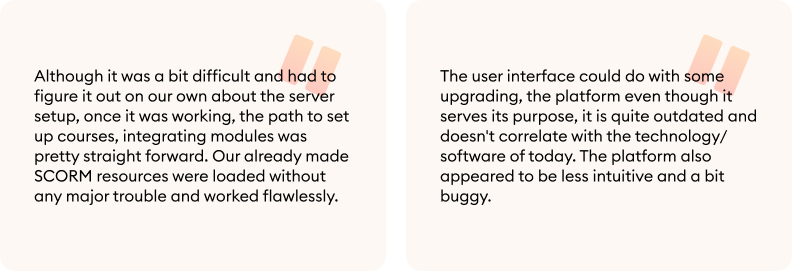
Moodle user reviews
The Top 6 Moodle Alternatives
The best Moodle competitors: A comparison table
Before we look at each tool in detail, let’s see how the Moodle competitors we selected compare across the key factors for choosing a learning platform.
| Essential LMS capabilities | Ease of use | Integration capabilities | Content authoring capabilities | Customer support | |
| iSpring LMS | Excellent | Easy to use, beginner-friendly | Excellent | Yes | 24/7 multi-channel support available |
| SkyPrep | Excellent | Easy to use | Good | Yes | Support available during official working hours |
| LearnWorlds | Excellent | Complex, involves a learning curve | Excellent | Yes | Email support available 24/7 |
| Google Classroom | Good | Easy to use, beginner-friendly | Limited integrations with other Google services | Only basic authoring capabilities | Limited support |
| Canvas LMS | Good | Easy to use | Good (mostly integrates with educational tools) | No | Multi-channel support available |
| LearnUpon | Excellent | Complex, involves a learning curve | Excellent | No | Multi-channel support available |
Now, let’s take a closer look at each eLearning tool and break down their pros, cons, and key differences when compared with Moodle.
Editor’s top choice:

iSpring LMS is a learning management platform for employee training and online learning. It works wonders for both medium-sized teams and larger organizations, like educational institutions and enterprises.
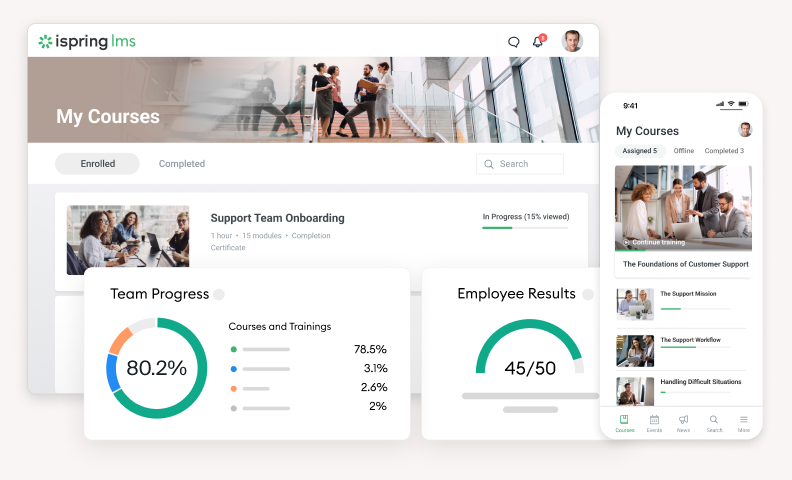
What makes iSpring LMS a great Moodle alternative is its comprehensive set of learning management capabilities. From automatic trainee enrollment to detailed learner progress reports, this LMS has everything you need to deliver, monitor, and improve training at scale.
iSpring LMS is an adaptive platform you can use for a variety of scenarios, including employee onboarding, compliance training, sales training, academic learning, and customer training. It’s easy to keep trainees engaged with smart gamification features and collaborative tools. Customization is made easy with white-labeling and numerous integrations with third-party tools.
For those teams that prefer creating learning content in-house, iSpring LMS offers a bundle with a powerful AI-enhanced authoring platform, iSpring Suite. You can design immersive courses with interactive quizzes, dialogue simulations, video lessons, and more right in PowerPoint or in your browser. All courses look great and work perfectly on any device. Speaking of devices, iSpring LMS comes with a native mobile app to enable learning on the go.
iSpring LMS pros and cons
Pros
- Excellent for tracking learner progress and employee performance
- Comes bundled with a robust AI-enhanced course creation tool
- Best-in-class tech support
- Intuitive mobile app
- Numerous integrations
Cons
- No free plan (although a free trial is available)
- Not the best solution for individual educators
iSpring LMS’s main differences from Moodle
- Offers a more modern and user-friendly interface compared to Moodle’s more traditional and utilitarian layout.
- Designed for quick setup and ease of use.
- Offers comprehensive customer support included in the subscription
- Provides a better mobile experience.
iSpring LMS pricing
Starts at $3.58 per user, per month, billed annually.
SkyPrep is another learning management system that can work as a solid Moodle replacement. It has a variety of features for automating training and optimizing learning management.
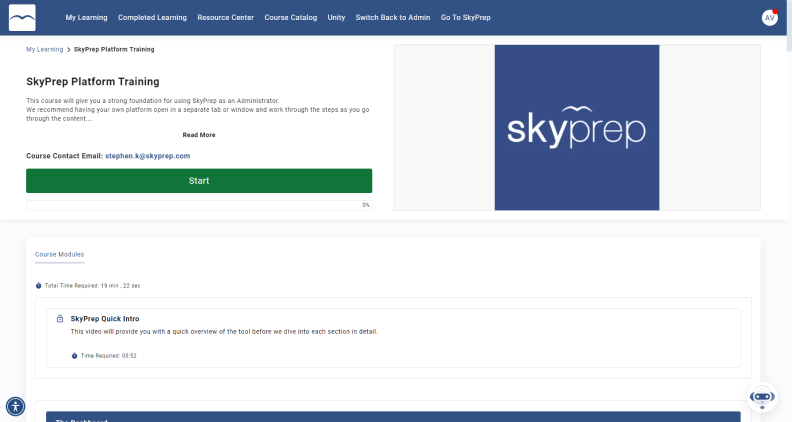
SkyPrep interface
SkyPrep has a strong progress tracking protocol and enables training managers to monitor employees’ skills and competencies with LMS reports. Learning paths help build individual training trajectories for each learner and create tailored learning experiences. Gamification and the intuitive UI of the platform facilitate learner engagement.
One of SkyPrep’s key features is its built-in course creation tool, SkyPrep Studio. It’s a simplistic eLearning content builder that will be a good match for organizations that need to quickly put together straightforward courses with quiz-based assessments.
For those teams and organizations that want to monetize their eLearning content, SkyPrep offers a course market. You can sell your content right in the LMS or use one of the available eCommerce integrations.
SkyPrep pros and cons
Pros
- Progress tracking features
- Course selling capabilities
- Simple setup and maintenance
Cons
- No round-the-clock customer support
- No free plan
- Nonintuitive reports
SkyPrep’s main differences from Moodle
- SkyPrep is better suited for businesses than for educational institutions.
- It offers a user-friendly content delivery system, while Moodle’s content management may require more manual configuration.
SkyPrep pricing
Upon request.
LearnWorlds is a popular all-in-one solution for online training. It combines an AI-powered authoring tool, an LMS, and a suite of marketing tools.

LearnWorlds interface
LearnWorlds is a great choice for organizations that want to control all aspects of training. You can create interactive courses in the vendor’s authoring tool, deliver them via the LMS, and track the effectiveness of your learning programs — all with a single solution.
Unlike many other LMS platforms, LearnWorlds has a more complex interface and navigation. This can become a problem if your organization or team doesn’t have a dedicated L&D manager ready to oversee the launch and use of the LMS. LearnWorlds compensates for this complexity with a wide range of features for convenient learning management, training result monitoring, and employee skill development.
LearnWorlds also promotes such capabilities as eCommerce, white labeling, and custom app development. This shows that the vendor targets larger enterprises that look for comprehensive, tailored LMS services.
LearnWorlds pros and cons
Pros
- AI-powered authoring tool
- Extended learning management capabilities
- Customizable website templates
- Integrated marketplace
- Extensive customer support
Cons
- No free plan
- Steep learning curve
- Inadequate functionality for educational institutions
LearnWorlds’ main differences from Moodle
- LearnWorlds promotes its solution as a business tool for enterprises.
- The platform focuses on eLearning monetization capabilities for clients.
LearnWorlds pricing
Starts at $24 per month.
Google Classroom is a free online learning platform that’s popular with teachers, independent educators, and students. It’s also a great choice for longtime Google Workspace users, since the platform is integrated with other Google services like Google Slides, Docs, Sheets, and Drive.
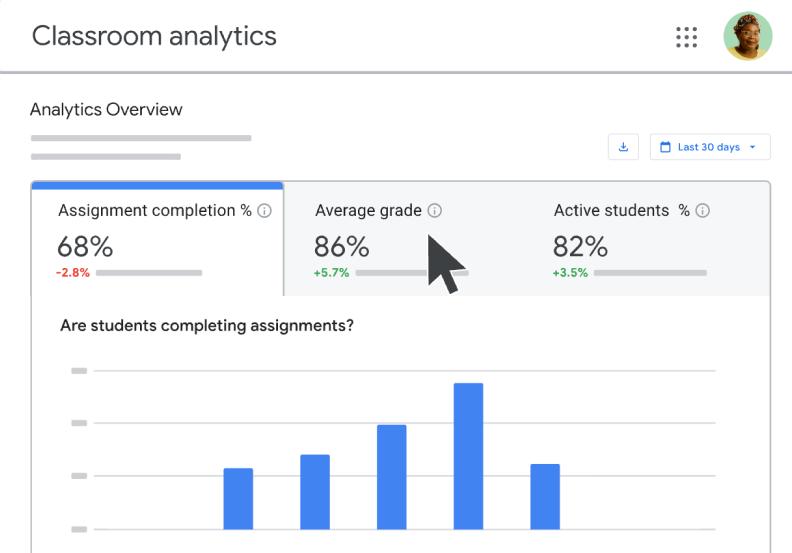
Google Classroom analytics dashboard
Google Classroom facilitates classroom management for both small and large groups of learners. Teachers can easily organize and distribute assignments, encourage group communication, and collect student submissions. You can see what your students are doing with learning materials in real time and track their progress continuously.
As the name of the tool suggests, holding online classes on the platform is easy and convenient, from inviting students to a lesson to assigning homework and discussing tasks together. However, Google Classroom has limited functionality beyond basic online learning features.
Google Classroom pros and cons
Pros
- Quick and easy setup
- Integrated with other Google services
- Great for collaborative learning
- Simple digital classroom management
Cons
- Unattractive UI
- Few customization options
- Limited tech support
Google Classroom’s main differences from Moodle
- Google Classroom is much simpler and has fewer capabilities than Moodle, which is why it’s not a good match for corporate training.
- Unlike Google Classroom, Moodle offers extended scalability and customization features.
Google Classroom pricing
While Google Classroom is an open-source platform, you can access additional features and support through G Suite for Education or Google Workspace for Education Plus subscriptions. They offer enhanced functionality and support options with a per user license fee.
Canvas LMS is another widely used platform designed specifically for schools, universities, and other educational institutions.
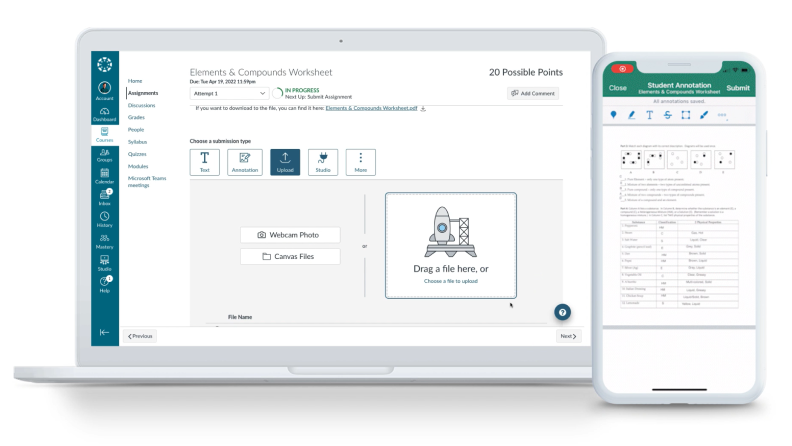
Canvas LMS interface
Canvas LMS developers claim they want the platform to be a teacher’s partner that facilitates the learning process with a comprehensive suite of tools. It is indeed a user-friendly LMS for educators and students alike, packed with essential features for effective knowledge transfer and the monitoring of learner progress. The LMS acts as a centralized digital storage for educational resources, as well as a content management system.
Scalability and customization capabilities help educators adjust their teaching strategies and improve curricula. On top of that, integrations with other educational tools serve to enhance learning efficiency. Canvas LMS also supports mobile learning with a dedicated app, although some users report that it’s slow and the UX could be improved.
Canvas LMS pros and cons
Pros
- Integrations with other educational tools
- Enhanced grading capabilities
- Mobile learning support with a native app
Cons
- No course creation capabilities beyond quizzes
- Limited analytics and reporting
- Occasional performance issues reported by users
Canvas LMS’s main differences from Moodle
- Canvas LMS is targeted at schools and other educational institutions, so businesses may find it less suitable for their needs than Moodle.
- The desktop version of Canvas LMS has a more user-friendly interface, both for educators and learners.
Canvas LMS pricing
Canvas LMS offers a free-for-teacher account with essential features and functionality for educational purposes. However, the vendor has a somewhat vague pricing structure for organizations. You’ll need to request a custom quote and provide your business credentials.
LearnUpon is a powerful LMS that will be a solid choice for businesses aiming to build, launch, and track employee training in-house.
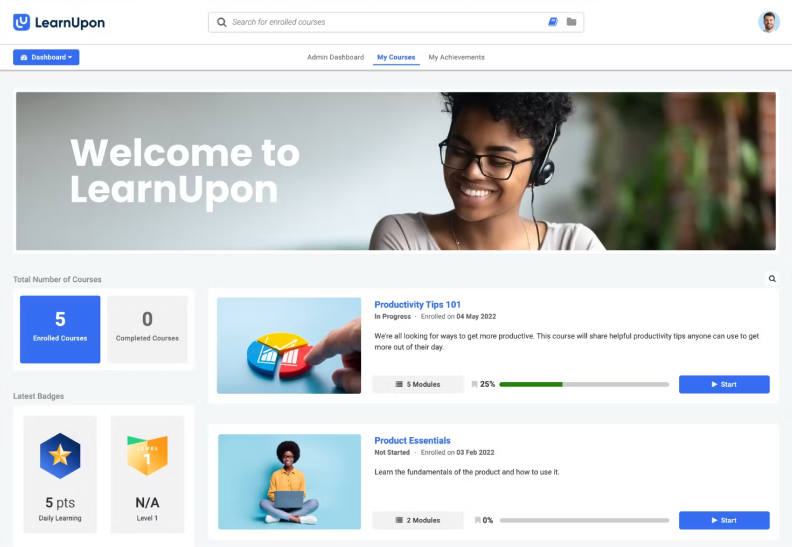
LearnUpon interface
LearnUpon offers a wide range of features for peer-to-peer learning with gamification mechanics to keep trainee motivation and engagement high. Learners can also pick extra programs from a catalog of off-the-shelf courses on various topics. Selling online courses is also an option, thanks to branded digital storefronts.
LearnUpon has incorporated AI into its LMS solution. Trainees can seek assistance from AI bots and build personalized learning paths based on a special algorithm that processes their preferences and previously completed courses.
The LMS places special emphasis on compliance training: you can automate certification management and optimize the audit process with ease. Detailed reports help training managers stay on top of learners’ progress and performance.
LearnUpon pros and cons
Pros
- Wide range of integrations
- AI-powered features
- Collaborative learning
- Off-the-shelf courses
Cons
- No authoring capabilities
- Complex reporting
- No offline learning available in the mobile app
LearnUpon’s main differences from Moodle
- LearnUpon focuses on business and enterprise customers.
- It has better platform customization features and white-labeling options.
LearnUpon pricing
Available after a live demo.
How to Choose the Right Moodle Alternative
To pick the best Moodle equivalent for your eLearning project, pay attention to the following factors:

Main factors for choosing a Moodle alternative
Software features
Start by outlining your specific requirements. Identify key software features that will enhance your educational offerings, like customizable learning paths, real-time collaboration tools, or detailed progress tracking. For instance, if your organization values data-driven insights, opt for an LMS with robust analytics features.
Integration capabilities
Then, evaluate the integration capabilities of each LMS you’re considering. It’s important that the system integrates smoothly with the other software your organization uses, such as Salesforce for CRM or Slack for communication, to ensure a seamless workflow and synchronization of data.
Quality of customer support
The quality of customer support is another critical factor. Consider platforms that offer comprehensive support, including live chat, extensive documentation, and community forums, to assist you with both the setup process and ongoing management.
User reviews
User reviews are invaluable for gaining insight into the practical use and reliability of an LMS. Browse through feedback on educational technology websites to see how other users rate their experiences regarding stability, user-friendliness, and support.
By weighing these factors — software features, integration capabilities, customer support quality, and user reviews — you can make a well-informed decision. Prioritize according to what will meet your educational goals best and facilitate effective learning and management.
Also read → How to select an LMS
Conclusion
As you can see, no two LMSs are the same — even if their feature sets look similar. So, if you’re considering switching from Moodle or experimenting with new online training software, make a note of the vendors listed above. Most LMS providers are happy to offer a free trial to give you a first-hand experience of their platform.
Speaking of which, you can try iSpring LMS for free for 30 days to test-drive all of its amazing capabilities for building a strong online training protocol in your organization. Or, book a free live demo with one of our eLearning experts. They’ll help you tailor the LMS experience to the requirements of your specific online training initiatives.



